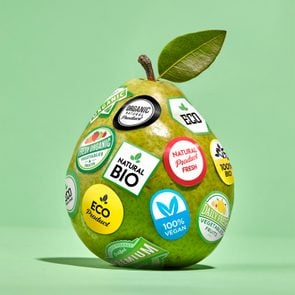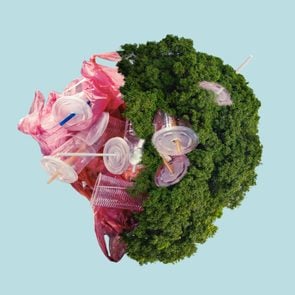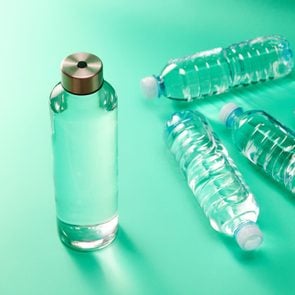What Is Greenwashing—and Why Should You Care About It?
Updated: Feb. 15, 2023

Greenwashing is essentially a lie. But there are sustainable brands out there telling the truth. This guide will show you how to tell the good from the bad.
A wise Harry Potter alum once said, “As consumers, we have so much power to change the world by just being careful in what we buy.” These are the words of actress and environmentalist Emma Watson. Known for advocating for sustainable brands on the red carpet, she is right. The companies that make the products we buy are paying attention to our shopping habits—so much so that, as environmental and social justice issues begin to influence our buying decisions, brands have taken notice with their own green marketing campaigns. Unfortunately, a lot of them are simply greenwashing. But what is greenwashing, exactly?
Think back to the last time you saw a fashion campaign of a model walking through fields of flowers in a collection of “sustainable” clothing. Or when you couldn’t find solid evidence of a clothing item’s eco-friendliness. Both are examples of greenwashing. It’s easy to say an item is sustainable. But it takes credible data, examples and certifications to prove it. If a company doesn’t include that information, it’s most likely because it’s spent its dollars on fancy campaigns, not making the changes necessary to be a responsible brand.
Of course, all of this can be incredibly frustrating for shoppers trying to practice sustainable living. “Greenwashing makes the seemingly straightforward decision to ‘buy better’ much more complex and exploits well-intentioned consumers by misleading their decision-making and clouding their ability to actually make a more sustainable purchase,” says Katie McCourt, founder and director of sustainable clothing brand Pantee. Thankfully, there are sustainable brands that are sharing with consumers how their products are made in an environmentally conscious way. And as consumers, when we understand what greenwashing is and how to spot it, we can make better buying decisions.
How do you identify greenwashing?
We have environmentalist Jay Westerveld to thank for helping us answer the question “What is greenwashing?” He coined the term in a 1986 essay when he noticed hotels promoting the reuse of towels through misleading sustainability claims. Since then, the term has been used anytime a brand is less than transparent about its sustainability efforts. According to McCourt, “transparency is key.” As a founder of an eco-friendly intimate apparel brand, she actively shares the materials, accreditations, factories and even clear-cut goals on the website.
When a brand doesn’t provide details to back up its claims, it’s probably greenwashing. If a brand’s materials are truly eco-friendly, it’ll share with customers the reasons why—products are made from recycled plastic or fabrics, for instance, or they have certifications proving their environmental friendliness. Identifying greenwashing is all about identifying the lack of actions and data that back up sustainable claims.
You can also identify greenwashing by looking for brands claiming to be 100% sustainable. Every product produced and purchased makes an impact. Sustainable brands aim to make the smallest impact, and they’ll tell you about the choices they made to get there and where they’re going. “The truth of the matter is that even though we’re committed to being as sustainable as possible, there are still ways in which we can improve—and that’s all a part of our journey,” McCourt explains.
What is an example of greenwashing?
Still wondering, “What is greenwashing?” Examples of the nine types of greenwashing will help you understand how some brands actively try to mislead customers.
What are the nine types of greenwashing?
-
Green by association: You may have seen a fast fashion brand feature models cuddling animals or walking in fields for its so-called sustainable collection. This is a form of greenwashing that involves putting clothes in nature to give the feeling that they’re environmentally friendly or green.
-
Lack of definition: When companies use vague buzzwords (like “green” and “nontoxic”) without backing up those marketing terms with a real explanation, they’re greenwashing.
-
Unproven claims: If a product is natural, net-zero, fair trade or recycled, there should be an explanation and/or certification to back the claims. Otherwise, if it sounds too good to be true, it probably is.
-
Bait and switch: It’s a classic tactic for a reason. A company will rope in eco-conscious buyers by promoting a sustainable product or product line while the bulk of its business focuses on traditional (read: not environmentally friendly) products and manufacturing.
-
The red herring: When a company highlights the one sustainable part of its brand but doesn’t acknowledge the ways in which it isn’t sustainable, that’s a red herring. It’s using misdirection to its advantage, like shouting loudly about its recycled paper packaging without acknowledging its flaws as a fast fashion brand.
-
Irrelevant claims: Some brands make it seem as if they’re eco-friendly through claims that are irrelevant. For instance, a brand might claim that it’s free of a certain chemical—a chemical that’s already banned by the federal government. So, technically, the brand didn’t go out of its way to make a difference.
-
Rallying behind a lower standard: True sustainability is about making the best decision. Sometimes brands will make the best economic decision to appear sustainable but not become sustainable. For instance, when the logging industry came under fire for damaging the environment, it could’ve made changes to improve its standards; instead, it created a program with less-rigorous standards.
-
Reluctant enthusiast: These brands listen to customers and realize that they must change if they want to continue making money. But the changes, if any, are made more for economic gain, not to protect the environment. Look no further than big oil. A study published in PLOS One in February 2022 found that oil companies are increasingly using terms like “climate” and “low carbon” and making pledges toward clean energy without insignificant spending in that area.
-
Outright lying: When a company ignores the truth but prefers to continue with green marketing, then it’s a lie. That can look like a fast fashion brand releasing “green” collections despite never making a change to its production or manufacturing process.
What companies are known for greenwashing?
Unfortunately for most fast fashion enthusiasts, brands that fit this descriptor—clothing companies that capitalize on trends and produce items quickly and cheaply—have the worst reputation when it comes to greenwashing. They’re notorious for outright lying, bait and switches, lack of definitions and even green-by-association tactics.
Companies that make plastic bottles are also frequent offenders—back when Nestle, one of the world’s biggest plastic polluters, announced its “ambition” to use 100% recycled plastic by 2025, Greenpeace slammed the company for not providing any clear targets for the goal. And, of course, big oil companies like ExxonMobil, BP, Chevron and Shell are guilty of playing up minimal environmental efforts while spending the large bulk of their money on oil and gas.
Some examples of these brands include:
Boohoo
The fast fashion retailer has consistently come under fire by consumers, activists and governments alike for its greenwashing claims. In 2021, critics took issue with its recycled collection. Experts noted that while the pieces were made from 95% recycled polyester, they were blended with elastin, which meant recycling the clothes wasn’t an option.
The brand also came under fire for labor violations when an investigation revealed that garment workers in its U.K. factories in 2021 were earning less than $5 per hour, which is well below the national legal minimum wage.
H&M
Another fast fashion behemoth that is notorious for greenwashing, H&M was even called out by Norway’s consumer watchdog, the Norwegian Consumer Authority. During the launch of an H&M “sustainable” collection in 2019, the Consumer Authority stated that there was little evidence to back up the claims. “Based on the Norwegian website of H&M, we found that the information given regarding sustainability was not sufficient, especially given that the Conscious Collection is advertised as a collection with environmental benefits,” said Elizabeth Lier Haugseth, the Consumer Authority director.
Zara
The brand launched a collection of clothing made from carbon emissions instead of virgin fossil fuels. The idea behind the collection was that it was sustainable because the polyester material could capture carbon emissions. But a deeper dive into the technology behind the material showed that the carbon-capturing fibers accounted for only 20% of the fabric used. Claims like this are misleading to customers and show a lack of transparency about the company’s sustainability claims.
ExxonMobil
Oil companies aren’t known for being particularly friendly to ol’ Mother Earth. Fossil fuels contribute greenhouse gases that contribute to climate change (and, you know, your climate anxiety), and oil spills pollute our oceans and harm wildlife. The bad press has driven ExxonMobil to promote green initiatives like its algae biofuels. But the bulk of its business is still dedicated to oil and gas, and according to at least one state, all that talk about algae is just greenwashing. In 2019, the state of Massachusetts even filed a lawsuit against the company for deceptive advertising.
Coca-Cola
On its website, Coca-Cola makes it easy to learn about its eco-friendly packaging. Sounds great, right? But according to a June 2022 report from the nonprofit Changing Markets Foundation, the millions of dollars the company spent to advertise bottles made with 25% marine plastic was just greenwashing. What Coca-Cola fails to mention: It’s the No. 1 global plastic polluter. According to the Break Free from Plastic Movement’s 2020 report, more than 13,800 plastics from the company were found in 51 countries, accounting for more pollution than the second and third global polluters combined.
How can you avoid greenwashing?
To reiterate, and to be honest, greenwashing is frustrating to both consumers and the people who are trying to build sustainable brands. Thankfully, some governing bodies around the world are acknowledging this frustration and are taking steps to change it. “The new Green Claims Code in the U.K. was implemented to ensure that organizations remain truthful and accurate and can back up their eco-claims to ensure they do not mislead customers,” says McCourt.
Until anti-greenwashing legislation takes a stronger hold in the United States, it’s up to consumers to learn what greenwashing is, put into practice tips for avoiding greenwashing and take other steps to reduce consumption and live a greener life.
-
Pay attention to fluffy language. Avoid vague claims or undefined explanations about how a product is sustainable.
-
Seek out certifications. If a brand took time for a third-party evaluation, it’s likely taken steps to be sustainable.
-
Ask questions. If you’re unsure about a brand’s sustainability claims, ask about them. Send the company an email or give a shout-out on social media to learn more.
-
Buy less and buy better. It always pays to be a smart shopper. Look for products you can use again and again, like reusable grocery bags and coffee cups. Shop slow fashion instead of fast fashion brands. And when you’re done with a product, find out how to recycle or upcycle it instead of tossing it in the trash.
All in all, taking the time to make better choices as a consumer pays off in the long run. It shows brands that you’re willing to back your morals with your dollars and that you’re supporting the brands that are truly making sustainable products by using eco-friendly materials, working to conserve water and save energy and doing their best to curb bad-for-the-earth practices. And that’s a win-win for your wallet and the planet.
Sources:
- Katie McCourt, founder and director of sustainable clothing brand Pantee
- PLOS One: “The clean energy claims of BP, Chevron, ExxonMobil and Shell: A mismatch between discourse, actions and investments”
- State of Massachusetts: “Attorney General’s Office Lawsuit Against ExxonMobil”
- Break Free from Plastic Movement: “The Coca-Cola Company, PepsiCo and Nestlé named top plastic polluters for the third year in a row”



